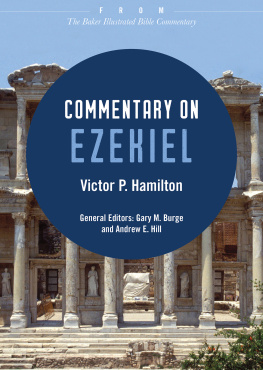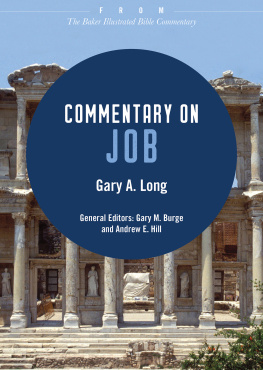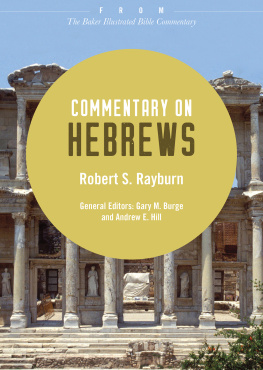Copyright Page
2012 by Baker Publishing Group
Published by Baker Books
a division of Baker Publishing Group
P.O. Box 6287, Grand Rapids, MI 49516-6287
www.bakerbooks.com
Ebook short created 2019
Previously published in The Baker Illustrated Bible Commentary edited by Gary M. Burge and Andrew E. Hill in 2012
All rights reserved. No part of this publication may be reproduced, stored in a retrieval system, or transmitted in any form or by any meansfor example, electronic, photocopy, recordingwithout the prior written permission of the publisher. The only exception is brief quotations in printed reviews.
Library of Congress Cataloging-in-Publication Data is on file at the Library of Congress, Washington, DC.
ISBN 978-1-4934-2478-8
Unless otherwise indicated, Scripture quotations are from the Holy Bible, New International Version. NIV. Copyright 1973, 1978, 1984, 2011 by Biblica, Inc. Used by permission of Zondervan. All rights reserved worldwide. www.zondervan.com. The NIV and New International Version are trademarks registered in the United States Patent and Trademark Office by Biblica, Inc.
Scripture quotations labeled ESV from The Holy Bible, English Standard Version (ESV), copyright 2001 by Crossway, a publishing ministry of Good News Publishers. Used by permission. All rights reserved. ESV Text Edition: 2007
Scripture quotations labeled NASB are from the New American Standard Bible, copyright 1960, 1962, 1963, 1968, 1971, 1972, 1973, 1975, 1977, 1995 by The Lockman Foundation. Used by permission. www.lockman.org
Scripture quotations labeled NIV 1984 are from the HOLY BIBLE, NEW INTERNATIONAL VERSION. NIV. Copyright 1973, 1978, 1984 by International Bible Society. Used by permission of Zondervan. All rights reserved.
Scripture quotations labeled NJPS are from the New Jewish Publication Society Version 1985 by The Jewish Publication Society. All rights reserved.
Scripture quotations labeled NKJV are from the New King James Version. Copyright 1982 by Thomas Nelson, Inc. Used by permission. All rights reserved.
Scripture quotations labeled NLT are from the Holy Bible , New Living Translation, copyright 1996, 2004, 2007 by Tyndale House. Used by permission of Tyndale House Publishers, Inc., Carol Stream, Illinois 60188. All rights reserved.
Scripture quotations labeled NRSV are from the New Revised Standard Version of the Bible, copyright 1989, by the Division of Christian Education of the National Council of the Churches of Christ in the United States of America. Used by permission. All rights reserved.
Scripture quotations labeled RSV are from the Revised Standard Version of the Bible, copyright 1952 [2nd edition, 1971] by the Division of Christian Education of the National Council of the Churches of Christ in the United States of America. Used by permission. All rights reserved.
Unless otherwise indicated, photos, illustrations, and maps are copyright Baker Photo Archive.
Contents
Abbreviations
| ANET | Ancient Near Eastern Texts Relating to the Old Testament . Edited by J. B. Pritchard. 3rd ed. Princeton, 1969 |
| BDAG | Bauer, W., F. W. Danker, W. F. Arndt, and F. W. Gingrich. Greek-English Lexicon of the New Testament and Other Early Christian Literature. 3rd ed. Chicago, 1999 |
| ca. | circa (about, approximately) |
| cf. | compare |
| chap(s). | chapter(s) |
| COS | The Context of Scripture . Edited by W. W. Hallo. 3 vols. Leiden, 1997 |
| e.g. | for example |
| ESV | English Standard Version |
| HALOT | Koehler, L., W. Baumgartner, and J. J. Stamm. The Hebrew and Aramaic Lexicon of the Old Testament. Translated and edited under the supervision of M. E. J. Richardson. 5 vols. Leiden, 19942000 |
| HCSB | Holman Christian Standard Bible |
| i.e. | that is |
| KJV | King James Version |
| NASB | New American Standard Bible |
| NEB | New English Bible |
| NET | New English Translation |
| NIV | New International Version (2011 edition) |
| NIV 1984 | New International Version (1984 edition) |
| NJB | New Jerusalem Bible |
| NJPS | The Tanakh: The Holy Scriptures: The New JPS Translation according to the Traditional Hebrew Text |
| NKJV | New King James Version |
| NLT | New Living Translation |
| NRSV | New Revised Standard Version |
| RSV | Revised Standard Version |
| TDOT | Theological Dictionary of the Old Testament . Edited by G. J. Botterweck and H. Ringgren. Translated by J. T. Willis, G. W. Bromiley, and D. E. Green. 8 vols. Grand Rapids, 1974 |
| TNIV | Todays New International Version |
1 Peter
Stephen Motyer
Introduction
Audience and Occasion
Peters first letter is called a General Epistle in that it was written not to one person or church but to all the churches greeted in 1:1. The precise regions listed are uncertain, for the terms could refer either to the Roman provinces so named or to the old ethnic groups and their associated areas, from which the Romans later adopted their official province names. It is most likely that the names are being used in their official sense, so the letter was probably addressed to all the churches in the northern half of Asia Minor (modern Turkey).
It is clear that Peters readers were facing persecution for their faith, and this has occasioned debate among scholars on several counts. Who instigated this persecution, and why? Was it official or unofficial? Was the persecution merely a threat, or was it already a reality? The answers to these questions are not easy to determine, but the following seems to be most likely. The persecution was probably unofficial and local, instigated by pagan neighbors of the Christian believers, perhaps with the support of minor local officials. It was certainly a present reality for some, if not all, of Peters readers. While the Roman Empire had an ambivalent attitude toward Christianity, and persecution was occasionally launched officially, this was rare compared with spasmodic local outbursts of hatred. And in this letter, the reasons given for the persecution are purely local. Peter mentions, for example, the annoyance caused by the Christians refusal to join in riotous festivals (4:4).
Because of this setting, 1 Peter has been called the Job of the New Testamentthe New Testament book that handles the theme of suffering most directly and intensely.

Authorship and Date
Few scholars today hold that the letter was actually written by the apostle Peter, largely on the grounds of style and language. First Peter is one of the finest examples of Greek prose in the New Testament, and scholars argue that Peter, who was an unschooled fisherman (Acts 4:13), could not possibly have produced such a work. In addition, the letter shows close affinities with Pauls writings, particularly the Letter to the Romans, and this too weighs against Petrine authorship. Alternative suggestions are that Silas drafted it as Peters secretary (see 5:12), so that the style is his but the substance Peters, or that it was written by another individual after Peters death and then attributed to him out of respect for his memory.














